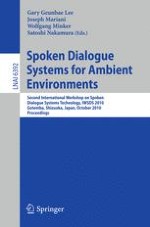2010 | Buch
Spoken Dialogue Systems for Ambient Environments
Second International Workshop on Spoken Dialogue Systems Technology, IWSDS 2010, Gotemba, Shizuoka, Japan, October 1-2, 2010. Proceedings
herausgegeben von: Gary Geunbae Lee, Joseph Mariani, Wolfgang Minker, Satoshi Nakamura
Verlag: Springer Berlin Heidelberg
Buchreihe : Lecture Notes in Computer Science
